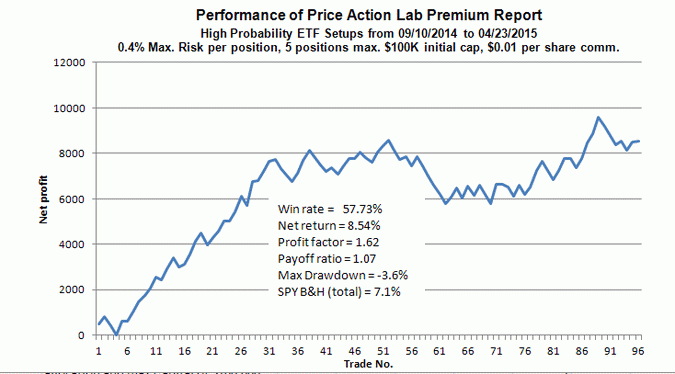This is a brief account of how I managed to beat the S&P 500 buy-and-hold return over the past six months, the mistakes I made and why I will not do it again this way.
Last year I started a daily premium service that offered quantitative analysis of popular ETFs and large cap stocks. On September 10, 2014, I started posting in that premium report precise entry and exit signals for high probability ETF setups (Click here for an excerpt of a daily report to see how the setups were presented.) Two open positions were closed at the open of last Thursday, April 23, 2015, and the daily premium service was terminated (There is now a new weekly premium service available.)
Below is the equity performance of the high probability ETF trading from 09/10/2014 to 04/23/2015. I briefly discuss next what I think I did right, where I think I failed and I explain why I would no longer do this for a daily report.
Performance of High probability ETF setups
Notes
The setups, along with specific entry and exit levels, were made available to subscribers before the market open and updated on daily basis. Therefore, they were audited in a way by the subscribers. Total number of closed trades: 96. Holding period varied from one to several days.
These are the theoretical results that include $0.01 commission per share. Normally, there would be slippage but not excessive because no market, MOO or MOC orders were involved other than in a couple of cases.
This performance was achieved with a small risk exposure. The average daily risk based on initial capital was less than 1%. Each position was sized so that maximum risk was 0.4% of initial capital and no more than five positions were open at any given time, for a maximum “portfolio heat” of 2%. Note that some, if not most, signal services overstate performance because they do not account for proper risk control and capital constraints. Click here for a blog post on this subject with the details, including position sizing formulas.
Trading has been hard especially this year but I managed to beat the buy and hold total return of SPY by about 140 basis points. Even if slippage was 1%, there is still outperformance of buy and hold. All names traded were very liquid: SPY, QQQ, TLT, IBB, EEM, IYR, to name a few.
What I did right
Part of what I did right was determining precise entry and exit levels that allowed calculating position size so that risk would stay close to 0.4% per position. As far as I am concerned, any other way eventually leads to a large drawdown or even ruin, although some are lucky enough so that “eventually” is after they retire. However, others are not that lucky and “eventually” is a few months or years down the road; it is probability and statistics. The risk of ruin is always there in trading and minimizing it requires keeping risk low and controlling it to stay low. This impacts returns but that is the way it goes and there is no escape from this trade-off. It is a law of trading.
What I did wrong
Although when a high probability setup is established there are specific exit levels, if the market shows good momentum, profits should be let run because this is one way that allows beating benchmark index returns. I did that a couple of times but I failed in others and especially in the case of TAN where I was happy to take a small gain although the setup signaled the start of a long trend. Failure of letting profits run is due to fear of losing (capital or profits) and this is one of the most difficult emotions to deal with. At the same time, it is hard to program a computer to do that, i.e., let profits run, because a specific method must be used and during a particular period of time it may not be the appropriate one due to the dynamics of price action. This is one reason that many are returning to discretionary trading.
Why I will not do again daily setups as a subscription service
Daily setups are a lot of work, doing the reports takes its toll on you, and to increase revenue a marketing person must be hired because there is no time doing both the reports and the marketing. Then, how do you price a service that beats buy and hold in a major index like the S&P 500? More importantly, how is performance affected when the number of subscribers increases? It may be a pure coincidence but I noticed that when there was a peak in the number of subscribers, the equity curve made a bottom. Therefore, it really does not pay doing this on a daily basis unless one works for a hedge fund that handles accounting, marketing and pays the salary.
During the period 2007 – 2008 I was trading for a Swiss hedge fund with Merrill as the broker. For those who know, that translated to huge slippage (I would not like to say anything else here, I have seen it all). I managed to survive then during the hard times. The owner of the fund blew up after a desperate move to smooth equity by buying low liquidity securities. I lost my profits and investment in this project because of his reckless behavior and greed. At one point he has leveraged the fund 4x and no one involved knew that. Now he manages a restaurant and I wish him good luck. But this could happen to anyone. This is why risk control is the key to survival in the markets. I emphasize survival because some naive traders think risk control is all it takes but it is useless in the absence of a robust edge. Trading in daily timeframes is viable as long as I can profit with 2% maximum portfolio risk. I could increase that to 3% maximum but not higher. If that does not work, then a diversified portfolio is the only option left. I am prepared for that too. For now, high probability setups work as there are plenty of opportunities left and the software I have developed allows me to identify them.
You can subscribe here to notifications of new posts by email.
Disclosure: no relevant positions.
Charting program: Amibroker
Disclaimer
© 2015 Michael Harris. All Rights Reserved. We grant a revocable permission to create a hyperlink to this blog subject to certain terms and conditions. Any unauthorized copy, reproduction, distribution, publication, display, modification, or transmission of any part of this blog is strictly prohibited without prior written permission.







